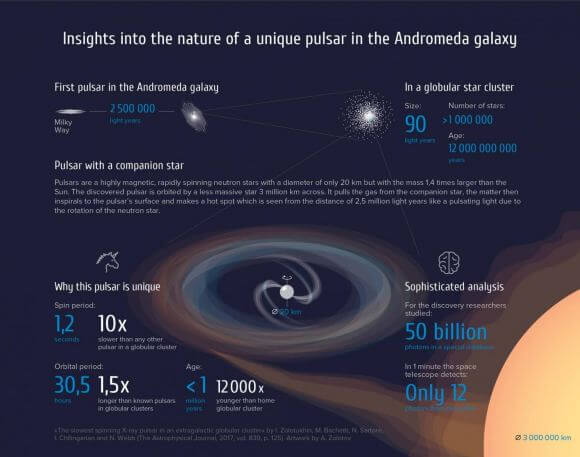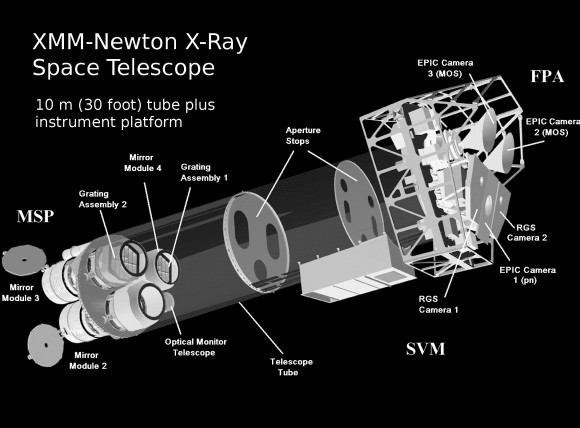When massive stars reach the end of their life cycle, they explode in a massive supernova and cast off most of their material. What’s left is a “milliscond pulsar”, a super dense, highly-magnetized neutron star that spins rapidly and emit beams of electromagnetic radiation. Eventually, these stars lose their rotational energy and begin to slow down, but they can speed up again with the help of a companion.
According to a recent study, an international team of scientists witnessed this rare event when observing an ultra-slow pulsar located in the neighboring Andromeda Galaxy (XB091D). The results of their study indicated that this pulsar has been speeding up for the past one million years, which is likely the result of a captured a companion that has since been restoring its rapid rotational velocity.
Typically, when a pulsars pairs with an ordinary star, the result is a binary system consisting of a pulsar and a white dwarf. This occurs after the pulsar pulls off the outer layers of a star, turning it into a white dwarf. The material from these outer layer then forms an accretion disk around the pulsar, which creates a “hot spot” that radiates brightly in the X-ray specturum and where temperatures can reach into the millions of degrees.
The team was led by Ivan Zolotukhin of the Sternberg Astronomical Institute at Lomonosov Moscow State University (MSU), and included astronomers from the University of Toulouse, the National Institute for Astrophysics (INAF), and the Smithsonian Astrophysical Observatory. The study results were published in The Astrophysical Journal under the title “The Slowest Spinning X-Ray Pulsar in an Extragalactic Globular Cluster“.
As they state in their paper, the detection of this pulsar was made possible thanks to data collected by the XMM-Newton space observatory from 2000-2013. In this time, XMM-Newton has gathered information on approximately 50 billion X-ray photons, which has been combined by astronomers at Lomosov MSU into an open online database.
This database has allowed astronomers to take a closer look at many previously-discovered objects. This includes XB091D, a pulsar with a period of seconds (aka. a “second pulsar”) located in one of the oldest globular star clusters in the Andromeda galaxy. However, finding the X-ray photos that would allow them to characterize XB091D was no easy task. As Ivan Zolotukhin explained in a MSU press release:
“The detectors on XMM-Newton detect only one photon from this pulsar every five seconds. Therefore, the search for pulsars among the extensive XMM-Newton data can be compared to the search for a needle in a haystack. In fact, for this discovery we had to create completely new mathematical tools that allowed us to search and extract the periodic signal. Theoretically, there are many applications for this method, including those outside astronomy.”

Based on a total of 38 XMM-Newton observations, the team concluded that this pulsar (which was the only known pulsar of its kind beyond our galaxy at the time), is in the earliest stages of “rejuvenation”. In short, their observations indicated that the pulsar began accelerating less than 1 million years ago. This conclusion was based on the fact that XB091D is the slowest rotating globular cluster pulsar discovered to date.
The neutron star completes one revolution in 1.2 seconds, which is more than 10 times slower than the previous record holder. From the data they observed, they were also able to characterize the environment around XB091D. For example, they found that the pulsar and its binary pair are located in an extremely dense globular cluster (B091D) in the Andromeda Galaxy – about 2.5 million light years away.
This cluster is estimated to be 12 billion years old and contains millions of old, faint stars. It’s companion, meanwhile, is a 0.8 solar mass star, and the binary system itself has a rotation period of 30.5 hours. And in about 50,000 years, they estimate, the pulsar will accelerate sufficiently to once again have a rotational period measured in the milliseconds – i.e. a millisecond pulsar.

Interestingly, XB910D’s location within this vast region of super-high density stars is what allowed it to capture a companion about 1 million years ago and commence the process “rejuvenation” in the first place. As Zolotukhin explained:
“In our galaxy, no such slow X-ray pulsars are observed in 150 known globular clusters, because their cores are not big and dense enough to form close binary stars at a sufficiently high rate. This indicates that the B091D cluster core, with an extremely dense composition of stars in the XB091D, is much larger than that of the usual cluster. So we are dealing with a large and rather rare object—with a dense remnant of a small galaxy that the Andromeda galaxy once devoured. The density of the stars here, in a region that is about 2.5 light years across, is about 10 million times higher than in the vicinity of the Sun.”
Thanks to this study, and the mathematical tools the team developed to find it, astronomers will likely be able to revisit many previously-discovered objects in the coming years. Within these massive data sets, there could be many examples of rare astronomical events, just waiting to be witnessed and properly characterized.
Further reading: The Astrophysical Journal, Lomonosov Moscow State University


“The density of the stars here, in a region that is about 2.5 light years across, is about 10 million times higher than in the vicinity of the Sun.””
Is Zolotukhin saying there are 10 million stars in an area 2.5 light years across? I would think that is impossibly high.
No, he is saying that the density in this space is 10 million times higher than what is around our Sun, not that there is 10 million stars.
with the closest star being about 4 light years away
and the Jovians being the closest heavy objects …
gives us about (2 × 10^27kg) × (1×10^7) = (2 × 10^34kg)
or about 10.000 Sun weights of 2 × 10^30kg
if i have done the math right …
A Sun’s weight for every sphere radius of 0,116 light year
or sphere radius of 7.336.000 AU.
Note:
Inner Oort cloud < 20.000 AU
Outer Oort cloud < 200.000 AU